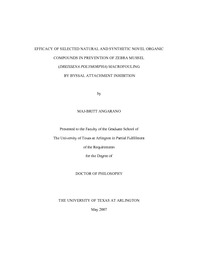
ATTENTION: The works hosted here are being migrated to a new repository that will consolidate resources, improve discoverability, and better show UTA's research impact on the global community. We will update authors as the migration progresses. Please see MavMatrix for more information.
Show simple item record
| dc.contributor.author | Angarano, Maj-Britt | en_US |
| dc.date.accessioned | 2007-10-08T23:55:03Z | |
| dc.date.available | 2007-10-08T23:55:03Z | |
| dc.date.issued | 2007-10-08T23:55:03Z | |
| dc.date.submitted | May 2007 | en_US |
| dc.identifier.other | DISS-1657 | en_US |
| dc.identifier.uri | http://hdl.handle.net/10106/639 | |
| dc.description.abstract | The invasive, freshwater, bivalve, Dreissena polymorpha (zebra mussel) was introduced to North America in the Great lakes in 1986 and has since spread throughout the waterway of the eastern and central United States and southeastern Canada. This species has imposed escalating economic burdens through its macrofouling of submerged structures and raw water using systems. Increasing restrictions on the chemical mitigation and control methodologies used to prevent their macrofouling, particularly organometallic or oxidizing chemicals, continue to stimulate research efforts to develop effective yet environmentally benign antifouling agents against this species and other macrofouling organisms. The efficacy in inhibiting zebra mussel byssal thread attachment was assessed for 29 potential antifouling compounds with structural or receptor ligand similarities to the active ingredient in hot peppers, capsaicin, and its analogue, anandamide. The acute lethality effects of these natural products were also tested on the non-target freshwater crustacean, Daphnia magna at varying compound concentrations.
Of nineteen compounds structurally similar to capsaicin, N-vanillylnonanamide (compound B) and N-benzoylmonoethanolamine benzoate (compound L) in addition to capsaicin itself (compound A) were shown to be potent inhibitors of mussel byssal attachment with extrapolated EC50 values in the micromolar range. Zebra mussel exposure to the remaining ten anandamide-like compounds demonstrated that O-2050 (compound Y), noladin ether (compound Z), CP 55,940 (compound AA), and AM630 (compound AB) significantly inhibited mussel byssal attachment, with estimated EC50 values also in the micromolar range. For the majority of compounds, mussels fully recovered capacity for byssal attachment 48 h post exposure. In contrast, three compounds, L, Z and AB, exhibited negative physiological impacts on zebra mussels leading to post-treatment byssal attachment inhibition and/or mortality. In general, none of the compounds deemed efficacious were lethal to D. magna at minimal concentrations inhibiting mussel byssal attachment. | en_US |
| dc.description.sponsorship | McMahon, Robert | en_US |
| dc.language.iso | EN | en_US |
| dc.publisher | Biology | en_US |
| dc.title | Efficacy Of Selected Natural And Synthetic Novel Organic Compounds In Prevention Of Zebra Mussel (Dreissena Polymorpha) Macrofouling By Byssal Attachment Inhibition | en_US |
| dc.type | Ph.D. | en_US |
| dc.contributor.committeeChair | McMahon, Robert | en_US |
| dc.degree.department | Biology | en_US |
| dc.degree.discipline | Biology | en_US |
| dc.degree.grantor | University of Texas at Arlington | en_US |
| dc.degree.level | doctoral | en_US |
| dc.degree.name | Ph.D. | en_US |
| dc.identifier.externalLink | https://www.uta.edu/ra/real/editprofile.php?onlyview=1&pid=89 | |
| dc.identifier.externalLinkDescription | Link to Research Profiles | |
Files in this item
- Name:
- umi-uta-1657.pdf
- Size:
- 487.6Kb
- Format:
- PDF
This item appears in the following Collection(s)
Show simple item record


